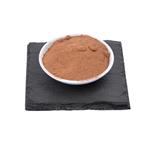What is Pectinase?
Pectinase is a collective term for enzymes that break down pectin and are as pectic enzymes. Polygalacturonase is one of the most well-known pectinase, and other common examples of this enzyme class include pectolyase and pectozyme. Pectin is a polysaccharide with a jelly-like consistency that is used to bind plant cells together.
The general biochemical effect of pectinase is to break down plant material, which makes it particularly useful for fungi that feed on plants. The middle lamellar layer in plants is especially high in pectin, allowing these fungal species to easily insert hyphae into this layer. The fungus can then extract nutrients from the plant.
Sources
Many molds and small amounts of bacteria and yeasts can produce pectinase, mainly Aspergillus and Bacillus, others including Penicillium (Penicillium expansum, Penicillium griseoroseum, etc), Sclerotium rolfsii, Rhizoctonia solani, Mucor pusilus, Mucor mucedo, Cloctridium thermosaccharolyticum, Rhizopus stolonifer, Aureobasiduim pullulans, Neurospora rassa, Sporotrichum thermophile, etc. As Aspergillus niger in fungi belongs to GRAS (General Regarded As Safe), its metabolites are safe, so currently marketed food grade pectinase is mainly from Aspergillus niger, and the optimum pH value is generally in the acidic range. With the continuous improvement of molecular biology techniques, gene cloning technology can also be used to achieve expression of pectinase in other microbial hosts.
Classification
Pectinase can be divided into four types: protopectinase, polygalacturonase, penctin lyase (PL), and pectinesterase (PE). Protopectalase can promote the dissolution of pectin. According to its catalytic mechanism, protopectinase is divided into two types: Type A pectinase and Type B pectinase. The former mainly acts on the inner polygalacturonic acid region of protopectin. The latter mainly acts on the outer polysaccharide chains of the galacturonic acid chains and cell wall components. Polygalacturonase is a kind of pectinase which promotes the hydrolysis of galacturonic acid chain under water environment.
According to different mechanisms of hydrolysis, it can be divided into two types: one is fungal exogalacturonase, its final product is monomeric galacturonic acid; the other is bacterial exogalacturonase, its final product is a dimeric galacturonic acid. Penctin lyase is a pectinase that cleaves pectic polymers by trans-elimination. The penctin lyase cleaves the glycosidic bond at the C-4 position while eliminating an H atom from C-5, resulting in an unsaturated product. According to its catalytic mechanism and different substrates, penctin lyase can be divided into endogalacturonase (EndoPGL), exogalacturonase (ExoPGL), endopolymethylgalacturonase (EndoPMGL), and exopolymethylgalacturonase (ExoPMGL). Pectinesterase can remove the methoxy group and promote the demethylation of pectin.
Properties
The molecular weight of pectinase is generally between 20kD and 60kD, and most of them exist as monomeric enzymes. Pectinase activity is usually in the range of pH 3.0 to 9.0, with an isoelectric point of 4.0 to 9.0. Among them, an optimum pH of a hydrolase is 4.0 to 6.5, and its action does not require the participation of Ca2+. The optimum pH of the penctin lyase is 8.0 to 10.0, and its action requires Ca2+ involvement. The pectinase produced by different strains has different properties. Common purification methods of pectinase include ammonium sulfate precipitation, acetone precipitation, ion exchange chromatography and gel filtration chromatography.
Applications
Pectinase can disrupt the cell wall of plant cells, which can be applied to the production of fruit and vegetable juices, the clarification of fruit wines, the extraction of natural products, the biological degumming of textiles, and the biological pulping of the paper industry. Most of the original juices and concentrated juices use pectinase during the production process. Because the pectin content in various fruits is quite different, and the composition of pectin is also slightly different, the enzyme composition of pectinase should be determined according to different varieties and processing purposes.
The existence of pectin influences or hinders the release of natural products to varying degrees. Under appropriate conditions, autolysis of plant cells can produce lytic enzymes including pectinase. However, this process can cause structural changes in the product to be separated, and even produce small molecule by-products that are not conducive to separation in most cases. Therefore, relying on the self-enzyme system of plant cells does not facilitate the extraction of natural products. In general, the intracellular enzyme system should be heat-inactivated before selecting the corresponding enzyme for processing.
The use of alkaline pectinase instead of alkali to process cotton, hemp and other fabrics, can remove the pectin material in the relatively mild pH and temperature conditions to make the treated fabric feel soft. This high-intensity process replaces the traditional hot-alkali degumming process that consumes large amounts of energy and is heavily polluted. Biopulping in the paper industry is similar to the biological degumming of textiles. Pectinases are used to degrade pectin, hemicellulose and lignin in plant fiber raw materials and disperse them into bundle fibers or monofilaments that meet different requirements of the paper industry.
You may like
Lastest Price from Pectinase manufacturers

US $0.00-0.00/g2025-04-21
- CAS:
- 9032-75-1
- Min. Order:
- 1g
- Purity:
- 98.0%
- Supply Ability:
- 1kg/month

US $120.00/kg2025-04-21
- CAS:
- 9032-75-1
- Min. Order:
- 1kg
- Purity:
- 0.99
- Supply Ability:
- 1000000
